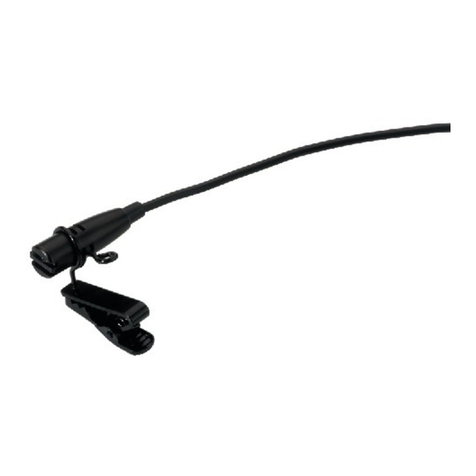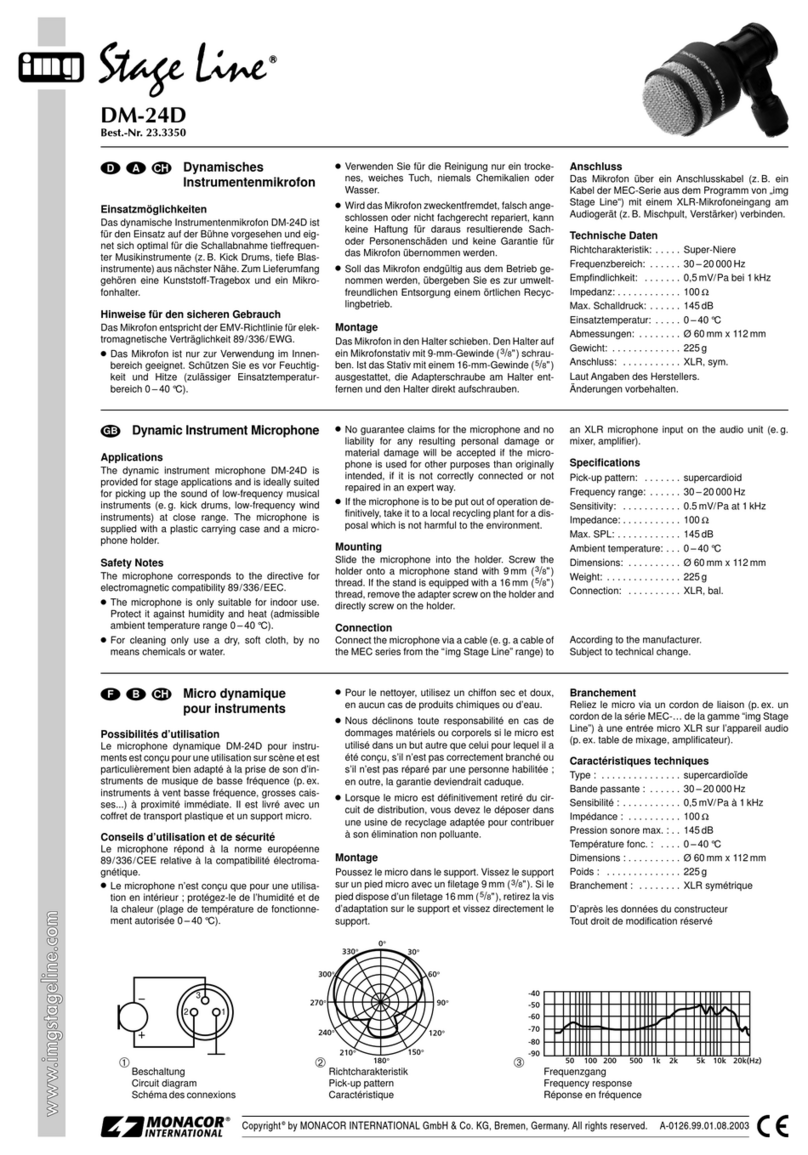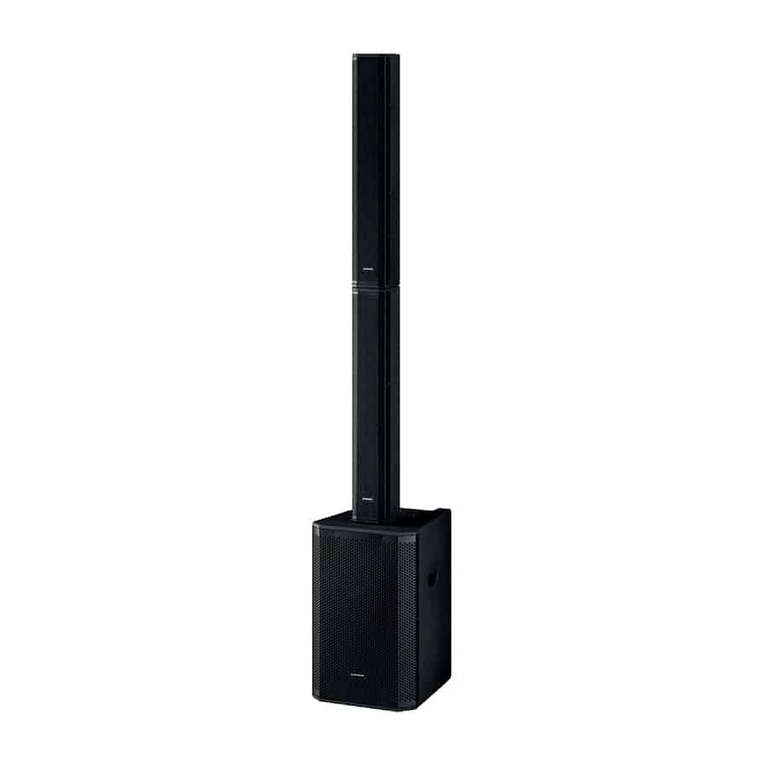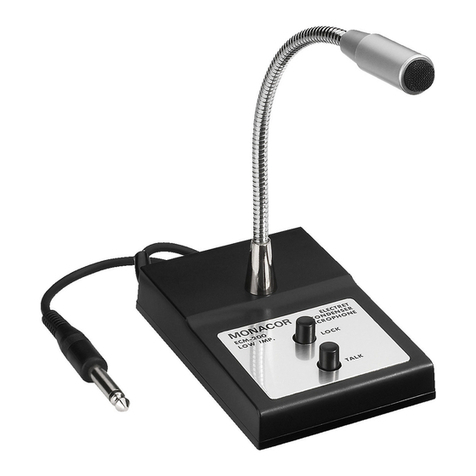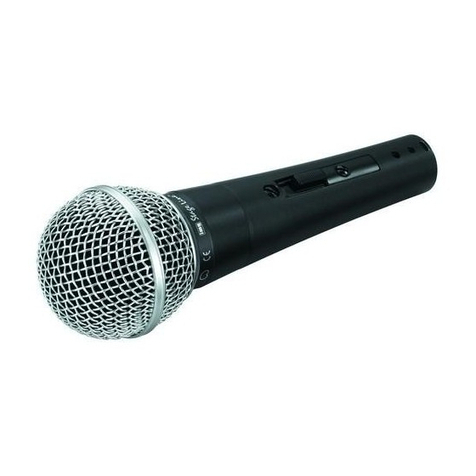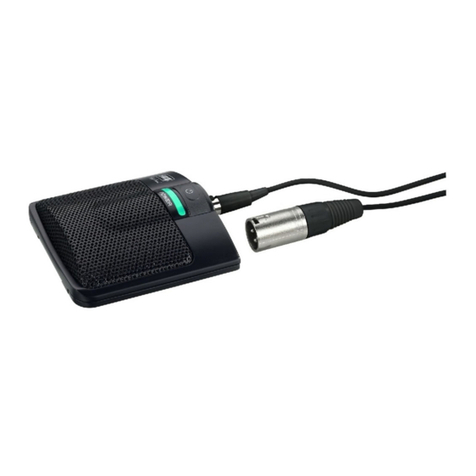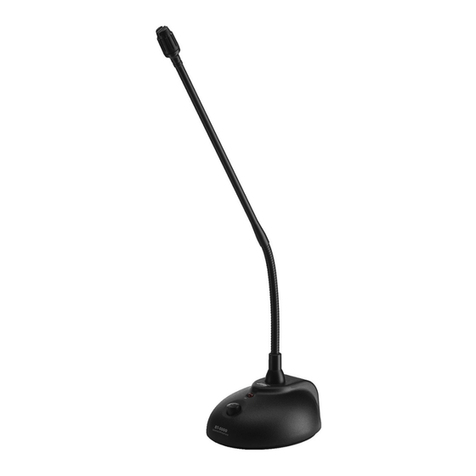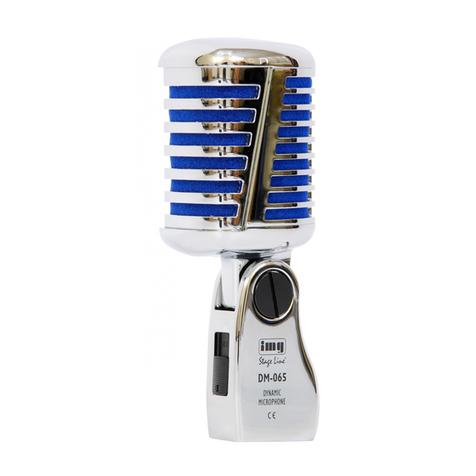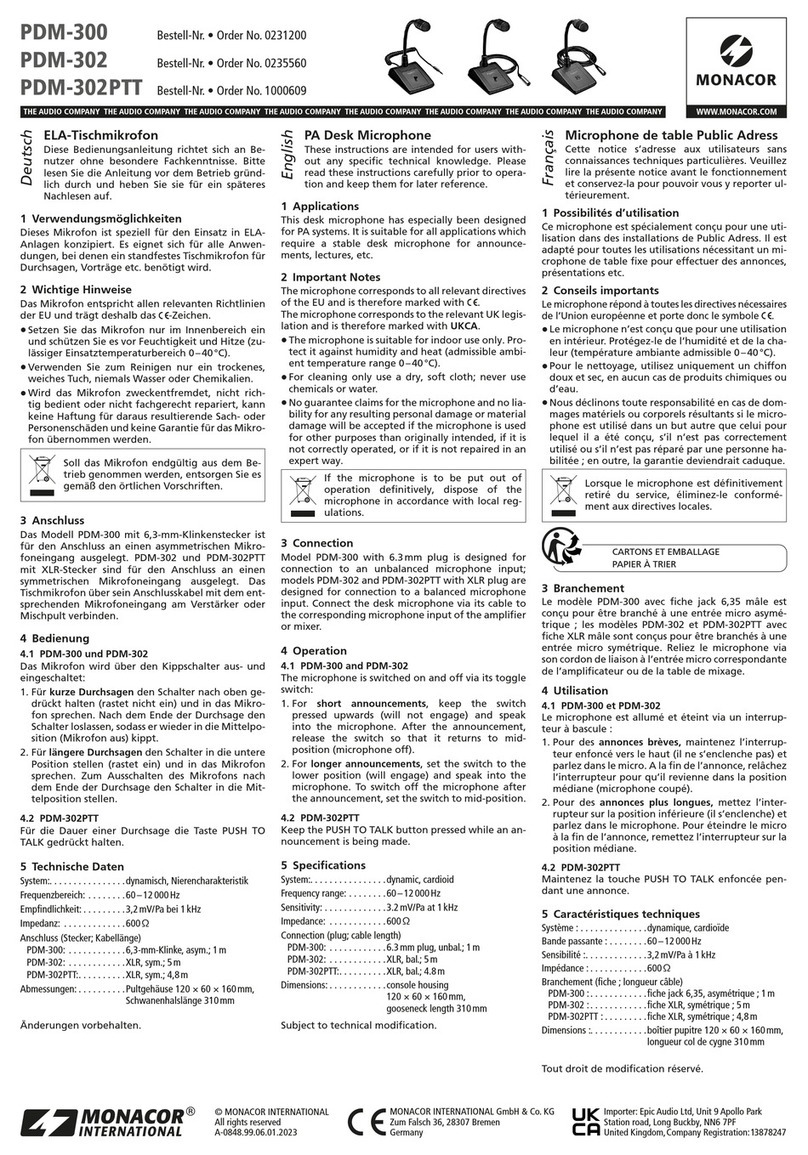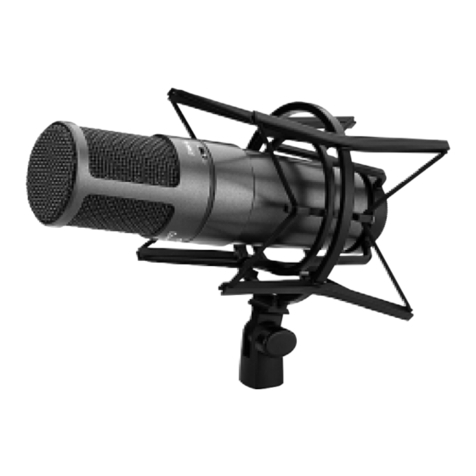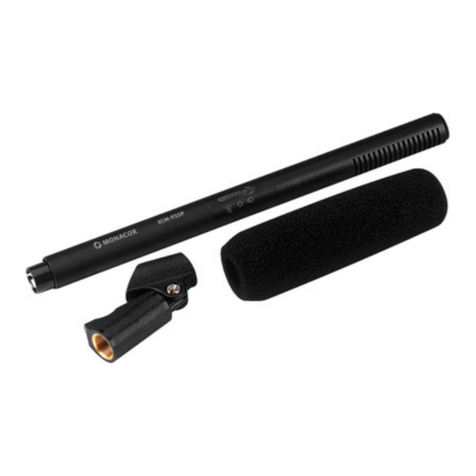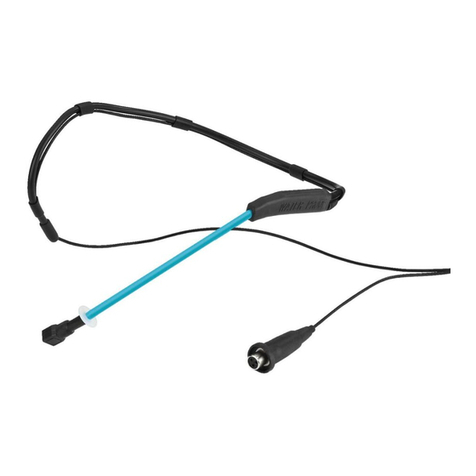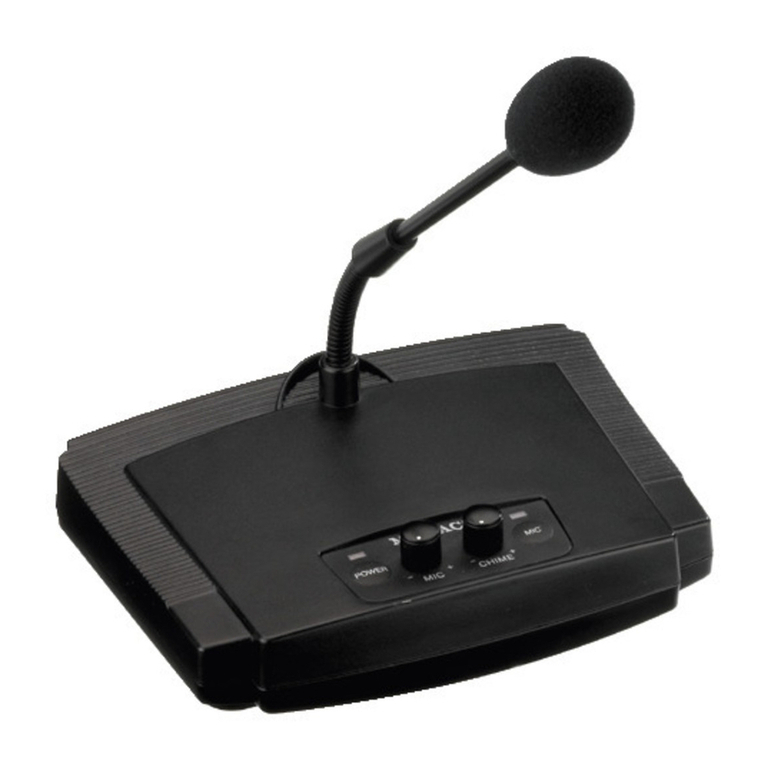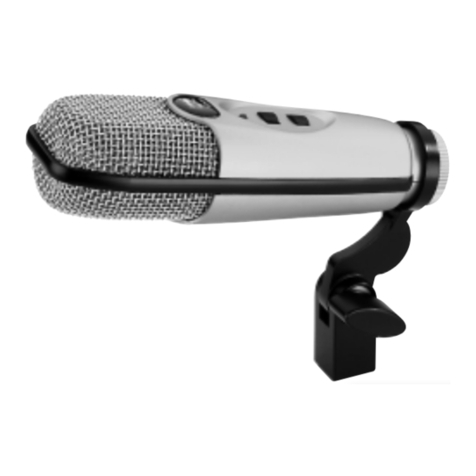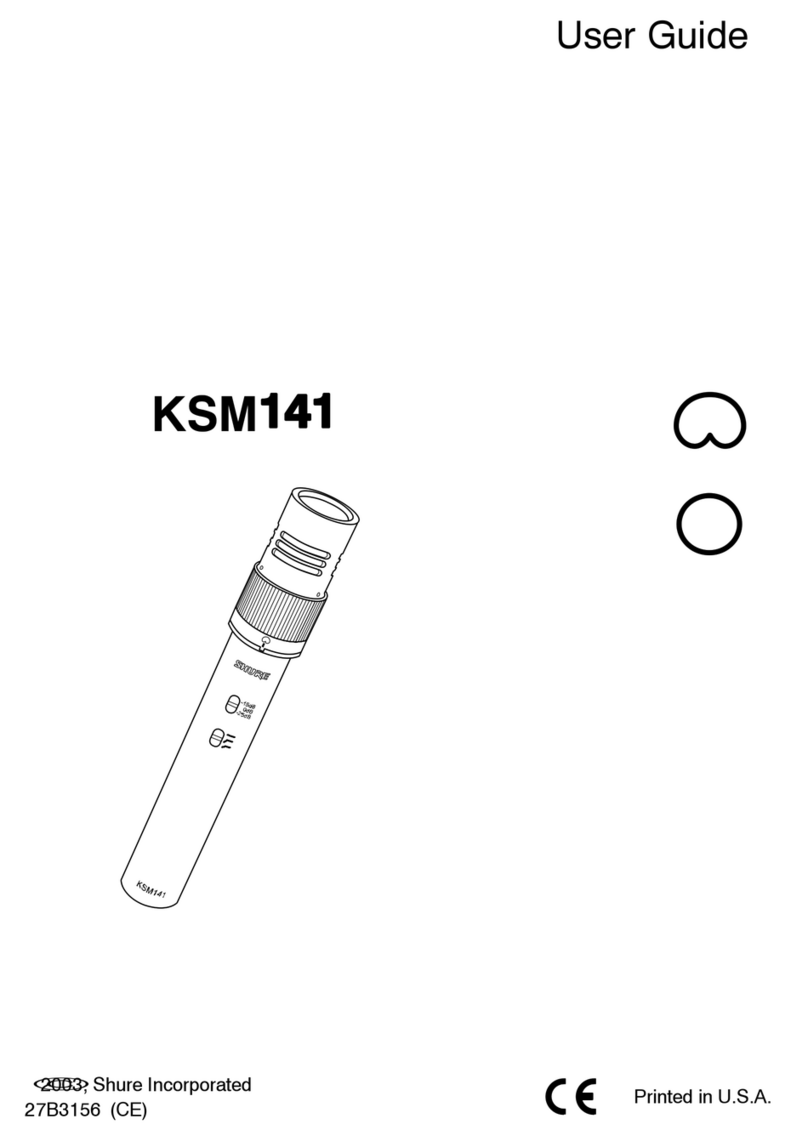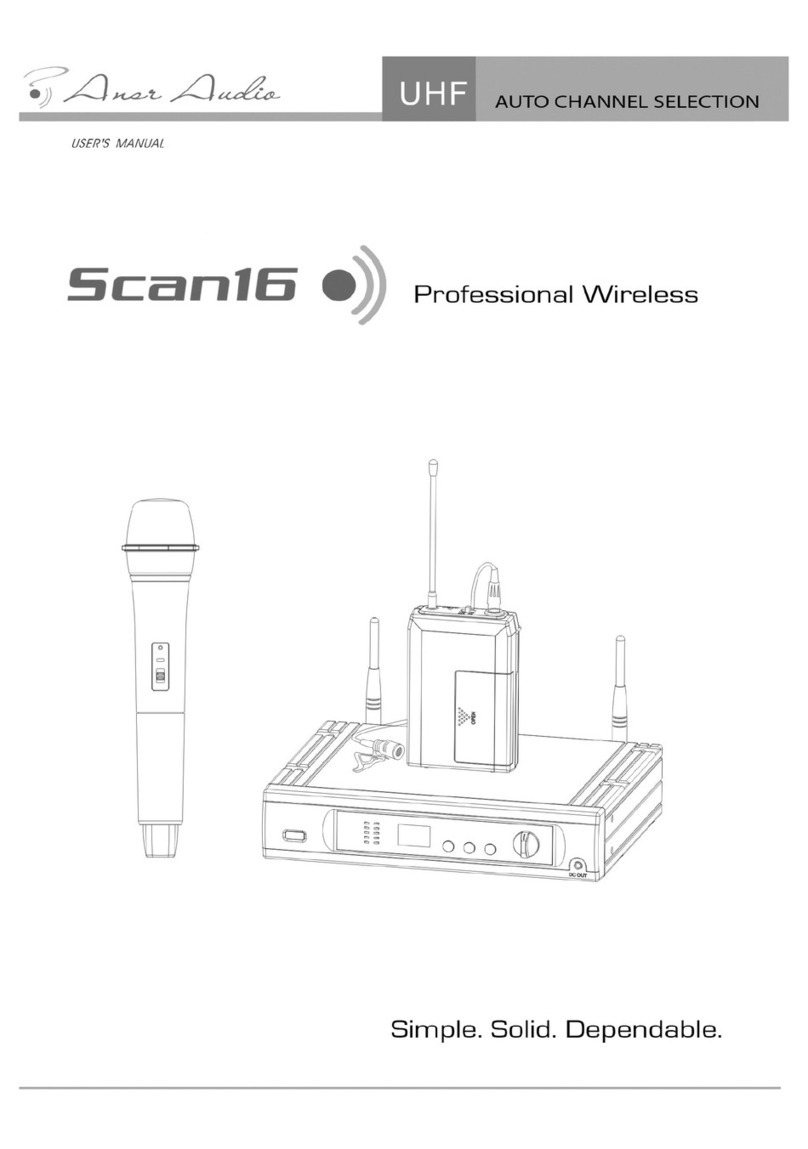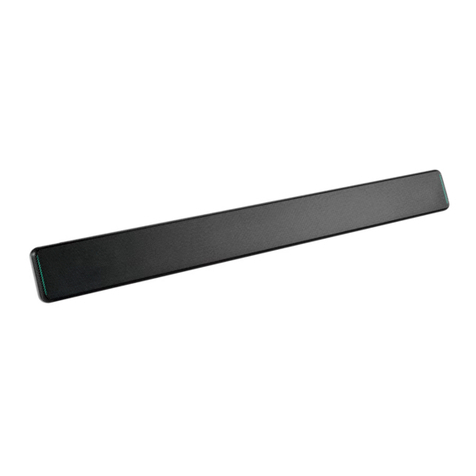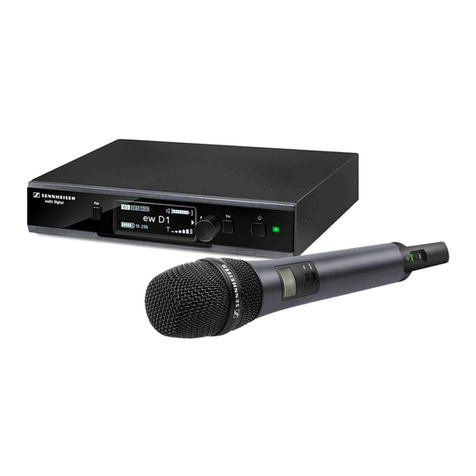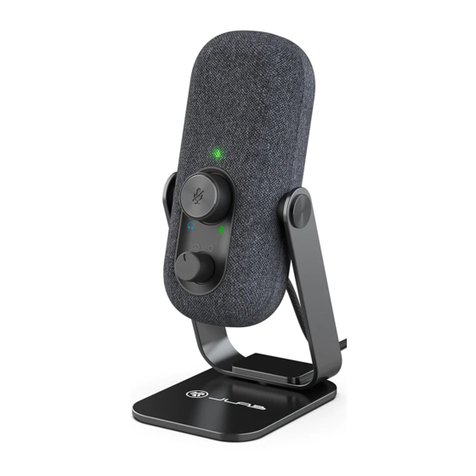Microfono headset
Vi preghiamo di leggere attentamente le presenti istruzioni
prima della messa in funzione e di conservarle per un uso
futuro.
1 Possibilità d'impiego
Questo microfono headset color pelle è previsto per l'uso
con il trasmettitore tascabile di un sistema wireless di tra-
smissione audio (p. es. un trasmettitore tascabile TXS-
...HSE con contatto mini XLR a 3 poli di “img Stage Line”).
Pertanto è adatto in modo ottimale per applicazioni di
canto e di voce parlata che richiedono un microfono non
vistoso che comunque offra della libertà di movimento, per
esempio durante rappresentazioni teatrali.
In alternativa al funzionamento con un trasmettitore ta-
scabile, il microfono può essere collegato anche con un
apparecchio audio, p. es. un mixer, per mezzo di un adat-
tatore di alimentazione (p. es. EMA-1 di “img Stage Line”),
che mette a disposizione l'alimentazione del microfono.
2 Avvertenze importanti per l'uso
Il microfono è conforme a tutte le direttive rilevanti dellʼUE
e pertanto porta la sigla .
GIl microfono è adatto solo per lʼuso allʼinterno di locali.
Proteggerlo dall'umidità e dal calore (temperatura dʼim-
piego ammessa fra 0 e 40 °C).
GPer la pulizia usare solo un panno morbido, asciutto; non
impiegare mai acqua o prodotti chimici.
GNel caso dʼuso improprio, di collegamenti sbagliati o di
riparazione non a regola dʼarte del microfono, non si as-
sume nessuna responsabilità per eventuali danni con-
sequenziali a persone o a cose e non si assume nes-
suna garanzia per il microfono.
3 Messa in funzione
Coprire il microfono con la cuffia antivento di materiale
espanso in dotazione. Sistemare l'archetto in testa e por-
tare il microfono in una buona posizione per parlare. A tale
scopo è possibile modificare la lunghezza del braccio del
microfono nel suo supporto.
Collegare il microfono con l'ingresso del trasmettitore
tascabile oppure collegarlo con l'ingresso microfono di un
apparecchio audio servendosi di un adattatore d'alimenta-
zione.
4 Dati tecnici
Con riserva di modifiche tecniche.
Modello HSE-130/SK HSE-132/SK
Tipo back-electret
Caratteristica
direzionale onnidirezionale cardioide
Gamma di frequenze
20 – 20 000 Hz
50 – 16 000 Hz
Impedenza 2kΩ
Sensibilità con 1 kHz 7,9 mV/Pa 5,6 mV/Pa
Pressione sonora max. 130 dB
Alimentazione 1,5–9Vtramite trasmettitore ta-
scabile o adattatore d'alimentazione
Peso 18 g
Contatto XLR mini, 3 poli
piedinatura:
1 = massa, 2 = segnale audio,
3 = alimentazione
Se si desidera eliminare il microfono definitiva-
mente, consegnarlo per lo smaltimento ad un'isti-
tuzione locale per il riciclaggio.
Micrófono de Cabeza
Lea atentamente estas instrucciones de funcionamiento
antes de utilizar el aparato y guárdelas para usos poste-
riores.
1 Aplicaciones
Este micrófono de cabeza de color carne está diseñado
para utilizarse en combinación con un emisor de petaca
de un sistema de transmisión de audio inalámbrico (p. ej.
un emisor de petaca TXS-…HSE con conexión mini XLR
de 3 polos de “img Stage Line”). Está diseñado especial-
mente para sonido vocal y discursos que necesiten mi-
crófonos discretos con mucha libertad de movimiento,
p. ej. para actuaciones en teatros.
Como alternativa para el funcionamiento con un emisor
de petaca, el micrófono se puede conectar a un aparato de
audio, p. ej. un mezclador, mediante un adaptador de ali-
mentación (p. ej. EMA-1 de “img Stage Line”) que sumi-
nistre corriente al micrófono.
2 Notas Importantes
El micrófono cumple con todas las directivas relevantes
de la UE y por lo tanto está marcado con el símbolo .
GEl micrófono está adecuado sólo para utilizarlo en inte-
riores. Protéjalo de la humedad y del calor (temperatura
ambiente admisible: 0 – 40 ºC).
GUtilice sólo un paño suave y seco para la limpieza; no
utilice nunca ni agua ni productos químicos.
G
No podrá reclamarse garantía o responsabilidad alguna
por cualquier daño personal o material resultante si el
micrófono se utiliza para otros fines diferentes a los ori-
ginalmente concebidos, si no se conecta adecuada-
mente o no se repara por expertos.
3 Puesta en Marcha
Coloque la espuma de protección entregada en el micró-
fono. Póngase la diadema y coloque el micrófono en una
posición óptima: para ajustar la longitud del brazo del mi-
crófono, mueva el brazo del micrófono en su soporte.
Conecte el micrófono a la entrada del emisor de petaca
o conéctelo a la entrada de micrófono del aparato de
audio, utilizando un adaptador de alimentación.
4 Especificaciones
Sujeto a modificaciones técnicas.
Modelo HSE-130/SK HSE-132/SK
Tipo Back electret
Captación Omnidireccional Cardioide
Banda pasante 20 – 20 000 Hz 50 – 16 000 Hz
Impedancia 2kΩ
Sensibilidad
a 1 kHz 7,9 mV/Pa 5,6 mV/Pa
SPL máximo 130 dB
Alimentación 1,5–9Vmediante emisor de petaca
o adaptador de alimentación
Peso 18 g
Conexión Mini XLR, 3 polos
Configuración de pines:
1 = masa, 2 = señal de audio,
3 = alimentación
Si va a poner el micrófono definitivamente fuera
de servicio, llévelo a la planta de reciclaje más
cercana para que su eliminación no sea perjudi-
cial para el medioambiente.
Mikrofony nagłowne
Przed rozpoczęciem pracy proszę zapoznać się z niniejszą
instrukcją a następnie zachować ją do wglądu.
1 Zastosowanie
Mikrofony nagłowne w kolorze skóry przystosowane są do
współpracy z nadajnikiem kieszonkowym bezprzewodo-
wego systemu transmisji audio (np. nadajnikiem TXS-
…HSE marki “img Stage Line”, wyposażonym w 3-pinowe
złącze mini XLR). Przeznaczone są do zastosowań mu-
zycznych oraz konferencyjnych, wymagających dużej swo-
body ruchu np. przy występach na scenie teatralnej.
Alternatywnie, możliwe jest podłączenie mikrofonu do
wejścia w urządzeniu audio np. mikserze. Wymagany do
tego jest adapter z zasilaniem phantom (np. EMA-1 marki
“img Stage Line”).
2 Środki bezpieczeństwa
Mikrofon spełnia wszystkie wymagania norm UE i dlatego
został oznaczony symbolem .
GMikrofon przeznaczony jest do użytku jedynie wewnątrz
pomieszczeń. Należy chronić go przed działaniem wil-
goci oraz wysokiej temperatury (dopuszczalna tempe-
ratura otoczenia: 0 – 40 °C).
GDo czyszczenia urządzenia należy używać suchej, mięk-
kiej tkaniny. Nie stosować wody, ani chemicznych środ-
ków czyszczących.
GProducent ani dostawca nie ponoszą odpowiedzialności
za wynikłe szkody (uszkodzenie sprzętu lub obrażenia
użytkownika), jeśli urządzenie było używane niezgodnie
z przeznaczeniem, nieprawidłowo podłączone bądź
poddane nieautoryzowanej naprawie.
3 Przygotowanie do pracy
Założyć piankowy wiatrochron na wkładkę mikrofonową.
Założyć uchwyt mikrofonu na głowę i umieścić wkładkę mi-
krofonową w pobliżu ust. Długość ramienia wkładki może
być regulowana poprzez przesuwanie jej w uchwycie.
Podłączyć mikrofon do wejścia w nadajniku kieszonko-
wym lub do wejścia mikrofonowego w urządzeniu audio
– poprzez adapter z zasilaniem.
4 Specyfikacja
Z zastrzeżeniem możliwości zmian.
Model HSE-130/SK HSE-132/SK
Typ Back electret
Charakterystyka
kierunkowa Dookólna Kardioida
Pasmo przenoszenia 20 – 20 000 Hz 50 – 16 000 Hz
Impedancja 2kΩ
Czułość przy 1 kHz 7,9 mV/Pa 5,6 mV/Pa
Max poziom SPL 130 dB
Zasilanie 1,5–9Vnadajnika kieszonko-
wego lub adaptera zasilania
Waga 18 g
Złącze Mini-XLR, 3-pinowy
Konfiguracja pinów:
1 = masa, 2 = sygnał audio,
3 = zasilanie
Po całkowitym zakończeniu eksploatacji, urzą-
dzenie należy oddać do punktu utylizacji odpa-
dów, aby zostało zniszczone bez szkody dla śro-
dowiska.
HSE-130/SK Bestellnummer 23.6400
HSE-132/SK Bestellnummer 23.6420
ELECTRONICS FOR SPECIALISTS ELECTRONICS FOR SPECIALISTS ELECTRONICS FOR SPECIALISTS ELECTRONICS FOR SPECIALISTS ELECTRONICS FOR SPECIALISTS ELECTRONICS FOR SPECIALISTS ELECTRONICS FOR SPECIALISTS
MONACOR INTERNATIONAL GmbH & Co. KG • Zum Falsch 36 • 28307 Bremen • Germany
Copyright ©by MONACOR INTERNATIONAL. All rights reserved. A-1561.99.01.05.2014
®
I E PL


